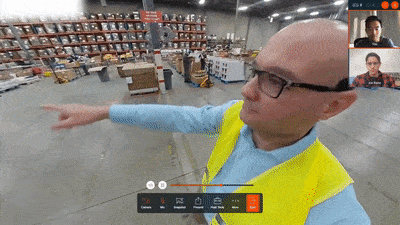Virtual inspections (and remote inspections) have become a permanent practice across many industries in the post-Covid world, especially for businesses with a global network of facilities and employees.
What started as a temporary solution, using familiar video conferencing tools like Zoom and Teams, led to businesses investing in emerging technologies like Avatour that drastically improved the effectiveness and overall experience of a virtual inspection.
If you manage one or two locations, virtual inspections may not be entirely useful. However, if you manage a number of different facilities, or oversee operations across different regions, virtual inspections could be massively beneficial.
Top 5 Benefits of Virtual Inspections:
- Travel Less
- Increase Efficiency
- Reduce Costs
- Improve Collaboration
- Reduced Carbon Footprint
Travel Less
Traveling to a jobsite or facility to conduct regular inspections is time consuming. Oftentimes, the amount of time spent going to and from the inspection site is much longer than the inspection itself.
Virtual inspections allow you to complete the inspection without having to leave your desk so you can take back all of the hours you spend on travel. No more arriving at the airport early or waiting in line at security.
Increase Efficiency
Remote inspections allow subject matter experts (SMEs) to participate more frequently without physically being on-site. SMEs can attend to a number of different sites and facilities at any given time while minimizing disruptions to the operation traditionally required with inspections.
For global teams, this also creates an opportunity to conduct inspections across more locations in a shorter period of time. What would typically take weeks to complete, traveling from one site to another, could be completed in a matter of days if conducted virtually.
Reduce Costs
According to Motus, a workforce management company from Boston, the average domestic business trip costs about $1,300 per person, and the average international trip costs about double that.
These expenses come from:
airfare (34%)
lodging (28%)
meals (19%)
ground transportation (18%)
Virtual inspections are much more cost-effective, and the more you use it, the more you save.
Improve Collaboration
Virtual inspections provide a platform for real-time communication between onsite and remote teams. This creates an opportunity for more frequent follow-ups and improved sharing of information to reduce miscommunication and errors.
Moreover, virtual inspections can remove communication barriers that may exist between onsite and remote teams. In case of situations where a last minute site visit is required, remote teams can jump in to address the problems quickly without delay.
Reduce Carbon Footprint
Reducing the number of in-person visits taken in a given year can make a significant impact on the company’s annual carbon footprint. Not flying makes the most direct impact on reducing carbon emissions as compared to other methods like carbon offset programs.
Takeaway
For large companies and teams managing multiple sites, virtual inspections are a game-changer. Routine inspections and audits can be completed in less time without the headaches of travel or coordinating an in-person visit.
Since the Covid pandemic, more and more virtual inspection tools have emerged offering unique benefits to those who understand its potential.
Further reading:
Why 360° is Better for Remote Inspections
How do 360-degree Cameras Work?
Comparing Immersive Technology for Remote Collaboration
About Avatour

Conduct virtual inspections in 360° with Avatour.
The Avatour platform brings teams together onsite – virtually – using live 360° video.
Remote inspectors have the ability to look around freely in a physical space while interacting with the operator onsite in real-time.
Learn more about Avatour for Inspections
